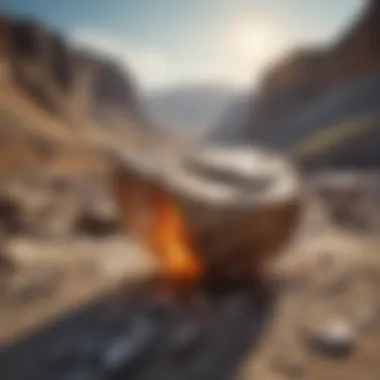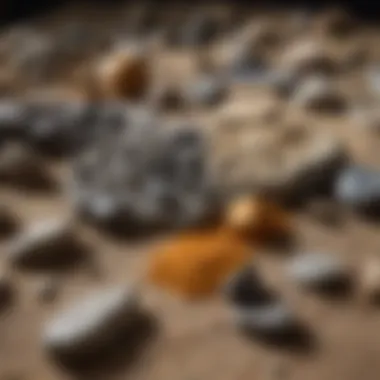Expert Guide to Selecting the Best Cutting Compound and Polish for Rock and Fossil Collectors


Rock and Fossil Identification
In the realm of rock and fossil collecting, the first crucial step lies in accurate identification. Understanding the various types of rocks and fossils is fundamental, guiding collectors towards differentiating between sedimentary, metamorphic, and igneous rocks, along with recognizing key characteristics such as color, luster, and crystal structure. These distinguishing features provide valuable insights into the geological processes that have shaped these specimens over millennia. Equipping oneself with essential tools like magnifying glasses, scratch tests, and field guides amplifies the accuracy of identification, transforming a hobby into a scientific pursuit.
Collecting Tips and Techniques
Engaging in rock and fossil collecting demands adherence to best practices and proven techniques. Seasoned collectors advise meticulously documenting the geological layers where specimens are found, as this aids in understanding the context of each discovery. Locating prime collecting sites requires a blend of research, field exploration, and networking within the collector community to identify locations rich in geological wonders. Furthermore, safely extracting specimens involves delicate handling and the use of specialized tools like rock hammers and chisels to ensure the integrity and preservation of valuable finds.
Preservation and Display
Preserving the beauty and integrity of collected rocks and fossils is paramount for enthusiasts. Employing techniques such as consolidants and sealants aids in stabilizing fragile specimens, preventing deterioration over time. Proper storage methods, including acid-free boxes and sponge cushioning, protect specimens from environmental factors like moisture and light degradation. For those seeking creative avenues, exploring innovative display ideas such as shadow boxes, glass domes, and custom-made stands enhances the aesthetic appeal of collections, transforming them into captivating showcases of geological marvels.
Geological Insights
Delving deeper into the geological aspects of rock and fossil collecting unveils a wealth of insights. Exploring the formations and processes that have sculpted the Earth's surface offers a profound understanding of its intricate history. Furthermore, unraveling the historical significance of rocks and fossils sheds light on past environments, ancient life forms, and evolutionary patterns. Studying notable discoveries in the field provides a glimpse into groundbreaking findings that have contributed to scientific knowledge and human fascination with the wonders of the natural world.
Preface
As we embark on the intricate journey of rock and fossil collection, the significance of cutting compounds and polishes unveils itself as a crucial aspect in our pursuit of uncovering the hidden beauty within geological wonders. This pivotal guide aims to shed light on the essential components that define the selection process of these transformative products, offering a roadmap for enthusiasts across all expertise levels. Whether you are a seasoned collector seeking to restore the luster of ancient fossils or a novice intrigued by the art of enhancing raw minerals, this guide will navigate you through the intricate realm of cutting compounds and polishes.
In this comprehensive investigation, we delve deep into the mechanics of cutting compounds, unraveling their role in the meticulous process of refining raw specimens. Simultaneously, we explore the nuanced art of polishing, illuminating how this final touch elevates the aesthetic appeal of rocks and fossils. By delineating the distinct types of cutting compounds available, including diamond-based formulations, aluminum oxide blends, and silicon carbide options, we equip collectors with the knowledge to make informed decisions based on the unique characteristics of each material.
As we venture into the realm of selecting the right polish tailored to different rocks and fossils, we decipher the intricacies of achieving the desired finish on diverse surfaces. Factors such as the hardness of the material, the texture of the surface, and the ultimate look desired play a pivotal role in guiding our choice of polish, ensuring impeccable results that elevate the visual allure of our geological treasures. Through a meticulous exploration of these facets, we aim to empower collectors with the expertise needed to make informed decisions when navigating the vast array of cutting compounds and polishes available within the market.


Furthermore
Understanding Cutting Compounds and Polishes
Understanding Cutting Compounds and Polishes play a pivotal role in the realm of rock and fossil collection. These compounds and polishes are not mere products; they are the craftsmen's tools, breathing new life into geological marvels. Whether it's reviving the subtle textures of ancient fossils or unveiling the inner beauty of rocks, the selection of cutting compounds and polishes significantly influences the outcome of the restoration process. Delving into the intricate world of these products unveils a realm where precision meets artistry.
The Role of Cutting Compounds
In the grand orchestra of rock and fossil restoration, cutting compounds take on the role of the maestro. Their abrasive properties delicately sculpt and shape the specimens, unveiling layers of history ingrained in rocks and fossils. The finesse of these compounds lies in their ability to harmonize harsh abrasion with meticulous detailing, paving the way for a transformative journey from rough exterior to polished brilliance.
Importance of Polishing in Rock and Fossil Collecting
Polishing in rock and fossil collecting acts as the final act of a theatrical performance, where the protagonists, the rocks and fossils, take center stage in their newfound glory. It is the refining touch that transforms raw, rugged surfaces into gleaming showcases of geological splendor. Each stroke of the polish enhances not just the physical appearance but also the narrative locked within these geological treasures.
Types of Cutting Compounds Available
Diamond-based Compounds
Diamond-based compounds stand as the epitome of precision and durability in the world of rock and fossil restoration. Their crystalline structure allows for unparalleled abrasion, delicately shaping even the most stubborn surfaces with precision akin to a master sculptor. While their upfront cost may deter some, their longevity and unrivaled performance make them a choice par excellence for connoisseurs seeking impeccable results in their work.
Aluminum Oxide Compounds
Aluminum Oxide compounds emerge as the reliable workhorses in the toolkit of rock and fossil enthusiasts. Their versatility and moderate abrasiveness make them ideal for a wide range of specimens, from softer rocks to more resilient fossils. What they lack in the sheer cutting power of diamond-based compounds, they compensate for in their adaptability, providing a balanced approach to restoration work.


Silicon Carbide Compounds
Silicon Carbide compounds stand at the intersection of efficiency and affordability, offering a middle ground for enthusiasts seeking competent results without breaking the bank. Their moderate hardness strikes a balance between precision and efficacy, making them suitable for a variety of materials without compromising on the quality of the final finish.
Choosing the Right Polish for Different Types of Rocks and Fossils
Selecting the appropriate polish for various rocks and fossils is akin to choosing the final brushstroke on a masterpiece. Each type of specimen comes with its own set of characteristics and quirks, demanding a polish that can complement and enhance its innate beauty. By understanding the unique properties of different polishes, collectors can ensure that every rock and fossil shines in its full glory, captivating both the eye and the imagination.
Factors to Consider When Selecting Cutting Compounds and Polishes
Selecting the appropriate cutting compounds and polishes for rock and fossil collecting is a nuanced process that requires careful consideration of various factors. One crucial aspect to analyze is the hardness of the material being worked on. The hardness level determines the type of cutting compound and polish that will be most effective in achieving the desired results. Understanding the hardness of the rocks or fossils you are dealing with is essential in selecting the right products to ensure efficient and successful polishing outcomes. Different materials require different levels of abrasiveness in cutting compounds and polish, highlighting the significance of assessing material hardness.
Texturing the surface is another critical factor to contemplate when choosing cutting compounds and polishes. The surface texture plays a vital role in determining the effectiveness of the products used. A rough surface may require coarser compounds for efficient cutting, while a smoother surface might necessitate finer polishes to achieve the desired finish. Considering the texture of the material before selecting the cutting compound and polish is crucial in tailoring the products to the specific surface properties, optimizing the polishing process, and enhancing the final appearance of the rocks or fossils.
Furthermore, defining the desired finish is an essential step in the selection process of cutting compounds and polishes. Different collectors may have varying preferences regarding the final appearance of their geological specimens. Some may prefer a high-gloss finish for a more polished look, while others may opt for a matte finish to highlight natural textures and patterns. Understanding the preferred finish allows collectors to choose the appropriate cutting compounds and polishes that align with their aesthetic goals, ensuring that the end result reflects their artistic vision and enhances the beauty of the rocks and fossils being worked on.
Application Techniques for Cutting Compounds and Polishes
Application techniques for cutting compounds and polishes play a pivotal role in the field of rock and fossil collection. Understanding the proper application methods is key to unlocking the full potential of these products and achieving exceptional results in the restoration and enhancement of geological specimens. Rock and fossil enthusiasts must grasp the nuances of these techniques to elevate their craftsmanship and attain superior outcomes.
To commence with, the application of cutting compounds demands precision and expertise. Choosing the appropriate compound for the specific rock or fossil being worked on is paramount. Different compounds cater to varying materials, each requiring a tailored approach for optimal effect. Factors such as hardness and texture must be carefully considered to ensure the chosen compound aligns perfectly with the geological specimen's properties.
Moreover, the application process itself relies heavily on skill and finesse. The manner in which the compound is applied, the pressure exerted, and the duration of the application all influence the final outcome. A thorough understanding of these application techniques empowers collectors to hone their craft and unveil the true beauty inherent in each rock or fossil.


Moving on to polishing techniques, similar attention to detail is indispensable. While cutting compounds set the foundation, polishes bring forth the exquisite luster and shine that captivate the eye. Selecting the right polish to complement the cutting compound utilized is crucial. Compatibility between the two products ensures a seamless transition from cutting to polishing, resulting in a flawless finish.
Finally, mastering the art of polishing rocks and fossils involves finesse and patience. Polishing requires a gentle touch and a systematic approach to gradually refine the surface and unveil the specimen's inherent beauty. Understanding the intricacies of different polishing methods and products is essential for achieving professional-grade results and showcasing geological wonders in their best light.
Step-by-Step Guide to Using Cutting Compounds
Tips for Maintaining and Extending the Lifespan of Cutting Compounds and Polishes
When delving into the realm of rock and fossil collecting, the significance of maintaining and extending the lifespan of cutting compounds and polishes cannot be underestimated. These products, instrumental in the enhancement and restoration of geological specimens, require careful attention to ensure optimal performance and longevity. By implementing effective maintenance practices, collectors can elevate their craft and preserve the quality of their prized collections.
One crucial aspect to consider when it comes to maintaining cutting compounds and polishes is proper storage. Ensuring that these products are stored in a cool, dry place away from direct sunlight and extreme temperatures is fundamental. Exposure to heat or moisture can compromise the integrity of the compounds, leading to diminished effectiveness. Therefore, investing in suitable storage solutions such as airtight containers or cabinets can go a long way in prolonging the shelf life of these essential tools.
Regular cleaning of cutting compound containers and polish application tools is another key factor in upkeep. Residual buildup can not only contaminate fresh batches of compounds but also impact the quality of the finishing work. By diligently cleaning containers, mixing vessels, and application brushes after each use, collectors can maintain a pristine working environment and ensure consistent results with every application.
Furthermore, periodic evaluation of the cutting compounds and polishes is essential in identifying signs of degradation or contamination. Visual inspections for discoloration, unusual odors, or changes in texture can indicate spoilage and necessitate disposal to prevent adverse effects on the rocks or fossils being treated. Conducting regular quality checks will enable collectors to replace expired products timely and safeguard the integrity of their projects.
In addition to storage and cleaning practices, adhering to recommended usage guidelines can significantly impact the lifespan of cutting compounds and polishes. Overextending the usage beyond specified limits can not only diminish the efficacy of these products but also pose risks to the user and the specimens. Following manufacturer instructions regarding application techniques, mixing ratios, and expiration dates is paramount in maximizing the utility and longevity of cutting compounds and polishes.
By conscientiously incorporating these maintenance tips into their rock and fossil collecting routine, enthusiasts can ensure the prolonged effectiveness and efficiency of cutting compounds and polishes, allowing them to continue producing exquisite results and preserving the beauty of their geological treasures.
The End
Concluding the intricate journey through the realm of selecting the finest cutting compounds and polishes for rock and fossil collectors, we arrive at a pivotal crossroads. The ramifications of this discussion reverberate within the core of the geological enthusiasts' essence. The fruition of meticulous choice-making in this realm manifests in the ability to restore and amplify the splendor encapsulated within petrified remnants of eras long past.
In essence, the conclusion gathers the scattered shards of wisdom imparted throughout this exposition. It acts as a beacon, guiding novice and seasoned collectors alike towards a realm of sublime geological refinement. The essence of selecting cutting compounds and polishes transcends mere utility; it is an art form, an alchemical process wherein raw stone yields to the deft touch of human craftsmanship.
Furthermore, the significance of the conclusion lies in its ability to bridge the chasm between intent and execution. As rock and fossil collectors stand on the threshold of choice, armed with knowledge and awareness, the conclusion serves as a compass, orienting them towards the most efficacious paths in their pursuit of beauty and authenticity.
Ultimately, the conclusion encapsulates the crux of this narrative: the power of informed choice in nurturing and enhancing the inherent majesty of geological marvels. It stands as a testament to the symbiotic relationship between collector and collected, an ode to the transformative potential that lies dormant within unassuming rocks and fossils. In this final deliberation, we witness the confluence of expertise, passion, and dedication, converging to elevate a mere pastime into a transcendent exploration of Earth's ancient splendor.







